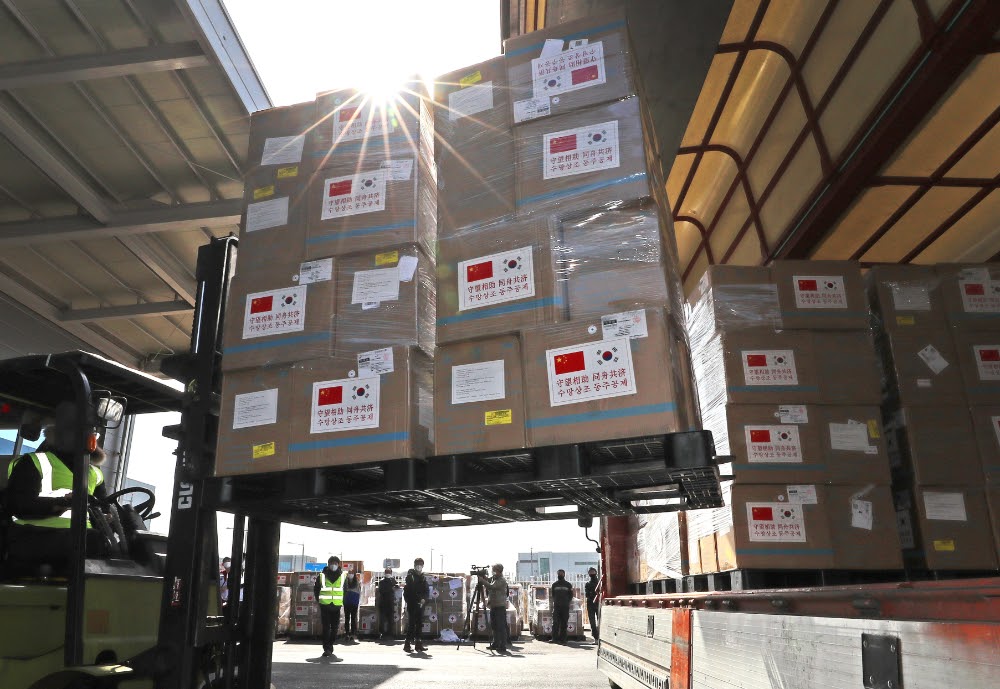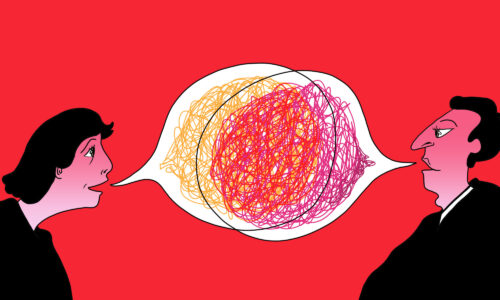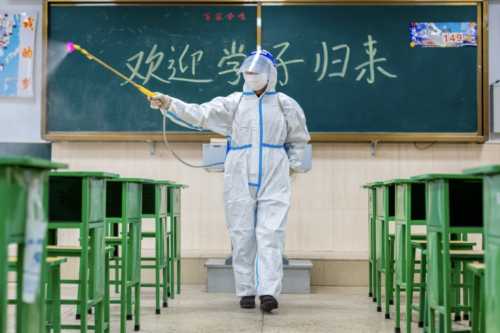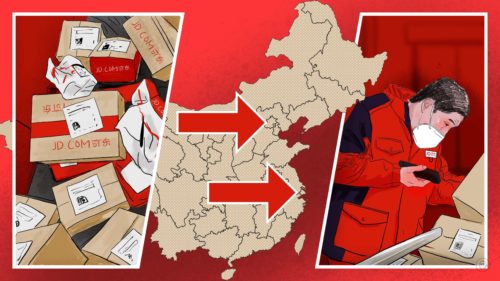‘Mask diplomacy’ and Twitter trolling from Beijing: does it work?


South Korean Red Cross workers load boxes of face masks and protective suits, donated by the Chinese government, into a warehouse in Incheon, west Seoul, South Korea on March 20. REUTERS/Yonhap News Agency.
By our count, dozens of countries have received, or are expecting to receive, some type of aid from China to fight COVID-19. We are using the term “aid” broadly: Sometimes medical supplies have been donated, at other times supplied for purchase, and the dispatching of supplies and personnel have been coordinated by a variety of state and private actors in China.
We could identify at least 15 countries that are reported to be direct recipients of medical aid “from China.” When possible, we have noted the source of the donations, but many reports say simply “donated by China”:
- Spain: 500,000 surgical masks “donated by China,” per Prensa Latina.
- Italy: “China has agreed to supply desperately needed medical equipment, including contracts for 10,000 pulmonary ventilators, 2 million face masks and 20,000 protective suits,” Weforum reports. It is unclear if these are donations; an earlier round of supplies was not. Xiaomi has donated tens of thousands of masks to Italy, according to the China Daily.
- Serbia: An unspecified number of COVID-19 test kits were donated by the Mammoth Foundation and the Beijing Genomics Institute (BGI), per a government press release.
- Czech Republic: 1.1 million FFP-2-level respirators, reports Reuters.
- Ukraine: 10 million tests, masks, disinfectant fluid, and ventilators are expected to arrive from China in the next two days, Reuters reports.
- Pakistan: “China had sent emergency assistance to Pakistan to combat coronavirus, which included 12,000 test kits, 300,000 face masks, and $4 million to build hospitals,” according to Chinese state broadcaster CGTN.
- Iraq: China sent a team of seven specialists from the Chinese Centre for Disease Control and Prevention the weekend of March 7. The experts “are expected to stay in Iraq for one month to help with testing, treatment and follow-up care of patients… According to the Red Cross Society of China, which is acting on behalf of Beijing, a shipment of diagnostic kits, medical supplies, and traditional Chinese medicine was also sent to Iraq,” per the SCMP.
- Iran: An unspecified number of medical specialists and supplies, including diagnostic tests, arrived in Iran on February 29, according to the SCMP.
- Japan: 5,000 sets of protective clothing and 100,000 masks donated by China, per China Daily.
- South Korea: 1.1 million masks and 10,000 protective suits, per Xinhua.
- Philippines: 2,000 “high-tech fast test kits” arrived from China on March 16, and another 10,000 were expected on March 18, reported Rappler.
- Cambodia: “2,016 fast test kits,” per the People’s Daily on Twitter.
- Sri Lanka: The country received a loan of $500 million from the China Development Bank to fight COVID-19, according to Newsfirst.
- Peru: 1,000 testing kits from the Mammoth Foundation and Beijing Genomics Institute (BGI), per Adina.
- Namibia: Has received “1,000 quick-testing kits for COVID-19,” which were “donated by Chinese Embassy and Best Novo high-tech company in China,” per the Chinese ambassador to the country.
Additionally, the Jack Ma Foundation coordinated the dispatch of doctors and medical supplies to France, Spain, Italy, Belgium, Iran, Iraq, the Philippines, Japan, and South Korea. The Jack Ma Foundation also said that it would donate 20,000 test kits, 100,000 masks, and 1,000 medical-use protective suits and face shields to each of the 54 countries in Africa, per the SCMP (which is owned by Jack Ma 马云 Mǎ Yún).
The 27 countries of the EU are also set to receive “two million surgical masks, 200,000 advanced masks and 50,000 testing kits” from China, according to the New York Times, and China has donated $20 million to the World Health Organization, reported the SCMP.
Why all the “mask diplomacy”?
This kind of “mask diplomacy,” as Brookings Institution scholars Cheng Li and Ryan McElveen have called it, was first employed by Japan last month during the height of the coronavirus outbreak in China, to shockingly positive effect. Perhaps learning a lesson from how well its own citizens responded to generosity with medical supplies, even from a longtime rival, China may be attempting a similar strategy itself.
Another theory of Beijing’s goals with this flurry of international activity, which also connects it to the conspiracy theories about the virus origin being spread by Chinese diplomats, was proposed by Yale law scholar Taisu Zhang in a ChinaFile conversation:
As always, the key to understanding China’s diplomacy…is to consider domestic political incentives. Both the helping hand it extended to Italy and its indulgence in conspiracy theories belie an urgency to seize control of the domestic political narrative on the pandemic…
International comparisons and blame-shifting offer a potential way forward… Assuming the virus remains contained in China — challenging given the overseas Chinese rushing home from Europe and North America — these comparisons should deliver at least a moderate public relations victory to the Party-state. The Trump administration’s almost unbelievable ineptitude itself virtually guarantees this.
In other words, the conspiracy theories from Chinese diplomats and the aid to foreign countries are two sides of the same coin:
- Conspiracy theories and finger pointing are designed to distract from domestic government incompetence.
- Extending aid to other countries is “a clear assertion of superior know-how and institutional competence.”
Neither tactic is guaranteed to work, but if China is actually successful in keeping the virus contained at home, and it continues to ravage the rest of the world, that will greatly help the odds. And as long as those two trends are true, or seem to remain true, Beijing appears set to triple down on this strategy. CCTV, for example, is eagerly taking up the task of pushing the conspiracy theories further — see this TV clip, or this article titled “10 questions for the US — Where did the novel coronavirus come from.”
Geopolitical implications
“This could be the first major global crisis in decades without meaningful U.S. leadership and with significant Chinese leadership,” Rush Doshi, director of the China Strategy Initiative at the Brookings Institution in Washington, told the New York Times.
Doshi, along with Kurt Campbell, the former assistant secretary of state for East Asia and Pacific affairs, explain their view in an essay in Foreign Affairs: China is maneuvering for global leadership during the coronavirus crisis as the United States falters. “Global orders have a tendency to change gradually at first and then all at once,” they note, and this has the potential to be a moment of rapid change.
For a different take on how China’s reputation might change with the crisis, at least among Americans, see in the Atlantic: China is trolling the world and avoiding blame.
Other important China-related COVID-19 news for today:
“Health officials in Taipei said they alerted the WHO at the end of December about the risk of human-to-human transmission of the new virus but said its concerns were not passed on to other countries,” the Financial Times reports (paywall).
China again reported zero new domestic cases today, notes Reuters. As we said yesterday, these numbers should be treated with caution. Meanwhile, Hong Kong reported 48 new cases today, including 12 cases of local transmission, per the Hong Kong Free Press.
—Lucas Niewenhuis, with help from Alex Smith and Jonathan Michel






